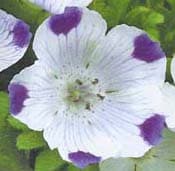How to Grow Five Spot Flowers

About Growing Five Spot Plants in Your Home Flower Garden
The Five Spot flower plant is a low-growing annual, that is great as a carpet or bedding plant. Native to the United States, it can be found growing naturally in meadows, by roadsides, and along woodlands. These annual plants are related to Borage and Forget-Me-Not. Growing annual Five Spot flowers is a snap. And soon your envious gardening pals will be asking you for Five Spot seeds to plant in their flower garden.
Five Spot gets its name from its flower. The bright white, one-inch flowers are, buttercup-shaped. Each of the five white petals has purple veins and a purple spot on the tip of the petal. It is a heavy bloomer from spring thru summer. When in bloom, the flowers attract beneficial insects and hummingbirds.
Try growing Five Spot in rock gardens, in the front of the flower bed, as a border edging, or in containers on your patio or deck. They are the perfect size for growing in flowerpots. And pm a balcony or deck, you can appreciate their bright, cheery blooms all summer long.
Did You Know? The Latin name for this flower is Nemophila Maculata. “Maculata” means spotted.
Five Spot Plant Specifications
Flower Colors: Five-petaled white flowers with blue to bluish-purple spots at the top of te petals.
Flowers Bloom: Spring thru summer.
Plant Height: Six to nine inches tall.
Light Requirements: Full sun to partial shade.
Ideal Soil pH: 6.5 – 7.5.
Hardiness Zone: 3 – 10. It grows well in most zones.
Toxicity: Non-toxic to humans.
Deer Resistant? Yes
Native To: California
Plant Type: Annual
Botanical Name: Nemophila Maculata
Number of Species: Eleven.
Other Names: This plant is also called Buffalo Eyes.
Medicinal Uses for Five Spot Plant
We found no pharmaceutical or home medicinal remedies that use five spot plants.
Light Requirements
Grow these plants in full sun in most zones. In hotter regions, grow them where they will receive shade from the hot sun in the afternoon.
Annual Five Spot Plant Propagation
Five Spot flowers are grown from seed. Directly sow seeds into your flower garden in the spring, after the danger of frost has past. You can also start them indoors 6 to 8 weeks before the last frost in your area.
Sow Five Spot seeds, 1/8″ to 1/16″ fine, loose soil. Then, keep the soil moist, but not wet while the seeds germinate and sprout.
For outdoor plantings, mark the planting spot, as germination can take up to three weeks.
Days to Germination: 7 – 20 days.
How to Grow Five Spot Flower Plants
Five spot plants are good re-seeders. So, select a planting location where they can grow undisturbed for many years. The plants grow best in cool weather. Grow plants prefer full to partial sun. In hotter climates, grow them in partial shade.
Five Spot thrives in most soils. It should be well-draining soil. If grown in poor soil, mix compost into the soil before planting.
In good soil, these light feeders may not need fertilizer at all. In poor soil, fertilize the plants every 6- 8 weeks, with a general-purpose fertilizer.
Water plants regularly, especially in hot, dry weather. Keep the soil moist, not wet. They do not like prolonged periods of wet, soggy soil which can increase the chances of plant disease.
Keep plants well weeded in the early growth stage, to allow them to get well established. Then, apply a thick layer of mulch to keep weeds down, and to retain soil moisture.
If you want Five Spot seeds to re-seed the area, allow a few flowers to remain on the plant until the flower has died and dried. Then, the five spot seeds will drop to the ground and are ready to sprout next spring.
Five Spot flowers are tender annuals. They will succumb to the first frost.
Pruning Five Spot Plants
Be vigilant and remove any dead or diseased leaves as soon as you see them. Sometimes you can control plant disease by the speedy removal of affected leaves.
Deadhead spent flowers, to promote more blooms.
Insects and Plant Disease
Perennial Five Spot can suffer from a variety of insect infestations and plant diseases.
Aphids, slugs, and spider mites can be a problem. Slug and snail bait is effective. Usually, neem oil works well for most other insects. Use chemical insecticides, as needed, for heavier infestations.
Mildew disease spreads quickly. They are most often spread by insects as they fly from one plant to another. So, insect control helps to control plant diseases, too.
Downy and powdery mildew are the most common plant disease problems. Use fungicides early, at the first sign of trouble. If you spot it on just a few leaves, immediately remove and discard the affected leaves into the trash barrel.
Also see: Plant Problems – Identify the causes and find the cures.
Related Articles
Also, people who read this article will like:
Plant Problems – Identify the causes and find the cures.
Please support our site. Shop for:
- rmmatthews100@hotmail.com
- 585-721-6528
- Rochester, NY
©1999-2024 GardenersNet.Com, All Rights Reserved

